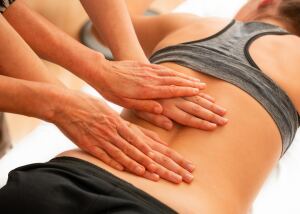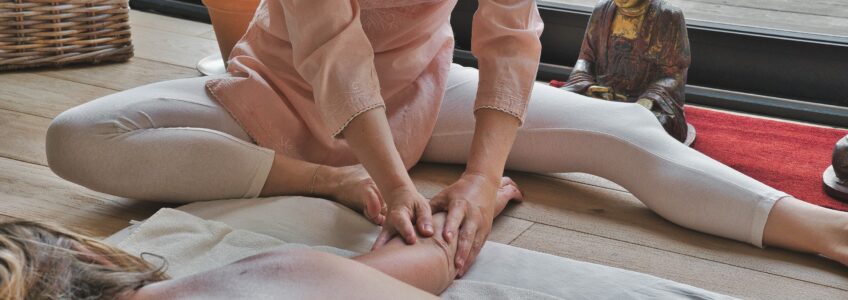Massage for the treatment of lower back pain is a holistic and therapeutic modality that has attracted attention in the context of a hectic life and the pressures exerted on the human body. In a world where stress, incorrect positions at the office and intense physical activities are the order of the day, lower back pain is becoming more frequent and more uncomfortable.
However, therapeutic massage has become an essential weapon in the arsenal of treatments for these conditions, offering a natural and non-invasive way to manage and reduce discomfort in the lumbar region. By applying specialized techniques and adapting them to individual needs, massage for lower back pain promises not only immediate relief, but also long-term benefits for the health of the back and the whole body.
In this article, we will explore the benefits, techniques, and correct approaches to massage therapy for low back pain, providing insights and helpful information for those seeking effective, natural solutions to this common problem.
CONTENT:
- The benefits of massage for the treatment of lower back pain
- Massage techniques suitable for the treatment of lower back pain
- When to avoid massage for lower back pain
The benefits of massage for the treatment of lower back pain
Massage is a therapeutic practice with multiple benefits when it comes to managing and reducing lower back pain. This non-invasive and natural method has gained popularity due to its ability to relieve lower back discomfort, offering multiple beneficial advantages for the body’s overall health.
-
Relaxation of tense muscles
Low back pain is often associated with tension built up in the muscles of the lower back. Therapeutic massage applied to this area has the ability to stretch and relax tense muscles. By manipulating and applying appropriate pressure on them, massage helps to reduce contractures and tension, providing relief and lessening the sensation of pain.
-
Improving blood circulation
Massage stimulates blood circulation in the affected area, facilitating more efficient blood flow to the muscles and tissues in the lumbar region. This helps speed up the healing process by providing essential nutrients and oxygen that are vital for healthy tissue repair and regeneration.
-
Reducing inflammation and stiffness
Specific techniques used in massage can help reduce inflammation and stiffness in the lower back. Through gentle movements and appropriate manipulations, massage can help relax tense tissues and reduce stiffness, while facilitating movement and increasing flexibility.
-
Release of endorphins
One of the outstanding benefits of massage is stimulating the release of endorphins in the body. These chemicals, known as “happy hormones”, have the ability to reduce the sensation of pain and induce a general state of well-being and relaxation. By releasing endorphins, massage not only relieves pain, but also improves mood and overall quality of life.

Massage techniques suitable for the treatment of lower back pain
To treat lower back pain effectively, it is crucial to apply correct massage techniques and see a therapist or manual therapy specialist. There are various massage techniques that have been proven to be effective in relieving lower back pain, offering a combination of relaxation, stimulation of blood circulation and reduction of muscle tension.
-
Pressure massage
This technique involves applying constant and controlled pressure to painful or tense
points in the lower back. By focusing pressure on these problem areas, pressure massage helps to deeply relax muscles and reduce discomfort. This method helps release tension and brings immediate relief to those with persistent lower back pain.
-
Massage with kneading movements
Kneading movements applied properly in the lumbar area are beneficial for relaxing tense muscles and improving blood circulation. These movements consist of rhythmic manipulations and controlled pressure, having beneficial effects on blood flow and muscle relaxation. By stimulating blood flow, this technique helps reduce pain and promote healing in the lower back.
-
Muscle stretching technique
The integration of stretching techniques and gentle manipulation of the muscles in the lumbar area into the massage is essential for relaxation and relief of accumulated tension. This technique allows the therapist to apply controlled movements, helping to stretch tense muscles and reduce pressure on the nerves and other structures in this area. By relaxing and stretching the muscles, this technique can reduce pain and stiffness in the lower back.
It is important to emphasize that the correct application of these massage techniques requires appropriate expertise and knowledge. Moreover, a skilled therapist customizes these techniques to individual patient needs, ensuring desired results in treating low back pain. Additionally, seeking a massage therapy specialist is vital to optimize these techniques for managing and reducing lower back pain.

When to avoid massage for lower back pain
There are specific circumstances where massage should be avoided or applied with caution to treat lower back pain. While therapeutic massage is generally helpful, specific situations or medical conditions might not be suitable for this therapy. It is important to consult a doctor or specialist before starting any massage treatment for the following conditions:
-
The presence of a severe infection or inflammation in the lumbar area
Massage on an acutely infected or severely inflamed lower back can worsen the condition and spread infection or exacerbate inflammation. In such cases, consulting a doctor before opting for massage therapy is crucial to avoid complications and ensure proper guidance.
-
Recent fractures or injuries to the back or spine
If there’s a suspected or confirmed diagnosis of back or spinal fractures or recent injuries, massage might not be recommended. Handling or applying pressure under these conditions can aggravate existing injuries and hinder the natural healing process. Seeking a doctor’s or specialist’s opinion before starting massage therapy in such cases is crucial.
-
Severe medical conditions such as tumors or chronic diseases
Massage for severe medical conditions requires careful, supervised handling. Some specific manipulations or improperly applied pressures can have negative repercussions or negatively affect the patient’s health.
In all these situations, consulting a doctor is essential before starting any massage treatment for lower back pain. A specialist will assess the patient and offer tailored recommendations for safe and effective treatment, preventing potential risks or complications.


